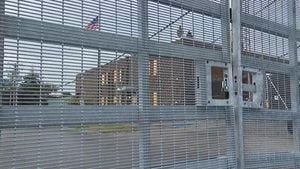For most people, a morning surf session is a chance to catch some waves and soak up the sun. But for David “Bean” Coffee, a 72-year-old surfer with decades of experience, his trip to Clancy Park in New Smyrna Beach, Florida, on August 26, 2025, turned into a dramatic rescue that would test the limits of his skills and endurance.
Just before noon, Coffee was out on his board enjoying what he thought would be a routine day in the water. The weather was typical for late August in Florida—warm, with the ocean shimmering under a cloudless sky. Coffee, who’s no stranger to the ocean, has spent more than half a century riding the waves up and down the coast. But as he paddled along, something out of the ordinary caught his attention.
“I just heard somebody yelling, screaming ‘Help! Help!’ … When I looked down the beach, pretty far out in the water, I saw a guy floating backwards, and I saw somebody else further in,” Coffee told WESH, his voice still tinged with the adrenaline of the moment.
What Coffee saw was a father and his son, both caught in the grip of a powerful rip current. Rip currents are notorious along Florida’s Atlantic beaches—fast-moving channels of water that can pull even the strongest swimmers away from shore in seconds. According to the National Weather Service, these currents are a leading cause of lifeguard rescues and drownings along the U.S. coastline.
The situation was already dire: the son’s surfboard leash had snapped, leaving him separated from his board and struggling to stay afloat. The father, meanwhile, was being pulled further out, his head barely above water. Without immediate help, the outcome could have been tragic.
Drawing on instincts honed over decades, Coffee sprang into action. He paddled as fast as he could toward the son, reaching him just in time. “If I wasn’t there, they would’ve been in the Bahamas or underwater. I just happened to be there, and good thing I was,” Coffee reflected, a mix of humility and relief in his words.
But the ordeal was far from over. After securing the son, Coffee turned his attention to the father, who by now was underwater and in grave danger. With a burst of energy, Coffee pulled the man to the surface and hoisted him onto his board. It was a feat that would have challenged even the youngest and fittest of surfers, let alone someone in their seventies.
“He was underwater. I had to pull him up out of the water and put him on my board,” Coffee recounted. The physical challenge was immense. “The rescues required some of the toughest paddling I’ve ever needed to do in my decades of surfing experience.”
As Coffee made his final trip back to shore with the exhausted father and son, emergency responders arrived on the scene. By then, both victims were safe, thanks to Coffee’s quick thinking and determination. The responders took over, ensuring the pair received any medical attention they needed, but the heavy lifting—quite literally—had already been done.
For Coffee, the rescue was a full-circle moment. More than 50 years ago, as a teenager, he worked a summer job as a lifeguard in Volusia County, the very stretch of coastline where he now surfs. In those days, his rescues were mostly minor—helping swimmers back to shore or keeping an eye out for trouble. He never imagined that, five decades later, those skills would be called upon for such a life-or-death situation.
“It was definitely a life-changing experience, just to be able to actually save two lives and to where they might not have ever been found,” Coffee told WESH. “Thank God I was there.”
Rip currents, while common, are often underestimated by beachgoers. The U.S. Lifesaving Association estimates that more than 80% of beach rescues are related to rip currents. They can form quickly and are difficult to spot, even for experienced swimmers. Coffee’s actions serve as a stark reminder of the dangers lurking just below the surface—and the importance of vigilance and preparedness at the beach.
Local authorities routinely urge swimmers and surfers to be aware of ocean conditions and to swim near lifeguard stations whenever possible. But on this Tuesday morning, with few others nearby, it was luck—and Coffee’s presence—that made the difference between life and death.
News of Coffee’s heroics quickly spread through the New Smyrna Beach community, where he’s a familiar face among the local surf crowd. Many who know him weren’t surprised by his actions. “Bean’s always been the kind of guy who looks out for others,” said a fellow surfer, who watched the rescue unfold from the shore. “He’s got a big heart and a cool head. That’s what you need out there.”
The rescued father and son, whose names have not been released, were reportedly shaken but unharmed. For them, a day at the beach turned into a brush with disaster—and a lesson in the unpredictable power of the sea.
Coffee, for his part, is modest about his role. He credits his years of experience and the training he received as a young lifeguard. “I’m just glad the skills I picked up as a teen proved useful so many decades later,” he said, a smile breaking through the seriousness of the moment.
Stories like Coffee’s resonate far beyond the local surf community. They remind us that heroes can be found in the most unexpected places—and that sometimes, a lifetime of quiet preparation pays off in the most dramatic way possible. As summer winds down and crowds return to Florida’s beaches, Coffee’s extraordinary rescue stands as both a warning and an inspiration: respect the ocean, look out for each other, and never underestimate the difference one person can make.
For David “Bean” Coffee, what began as an ordinary day became a testament to courage, skill, and the enduring spirit of those who answer the call when lives are on the line.




